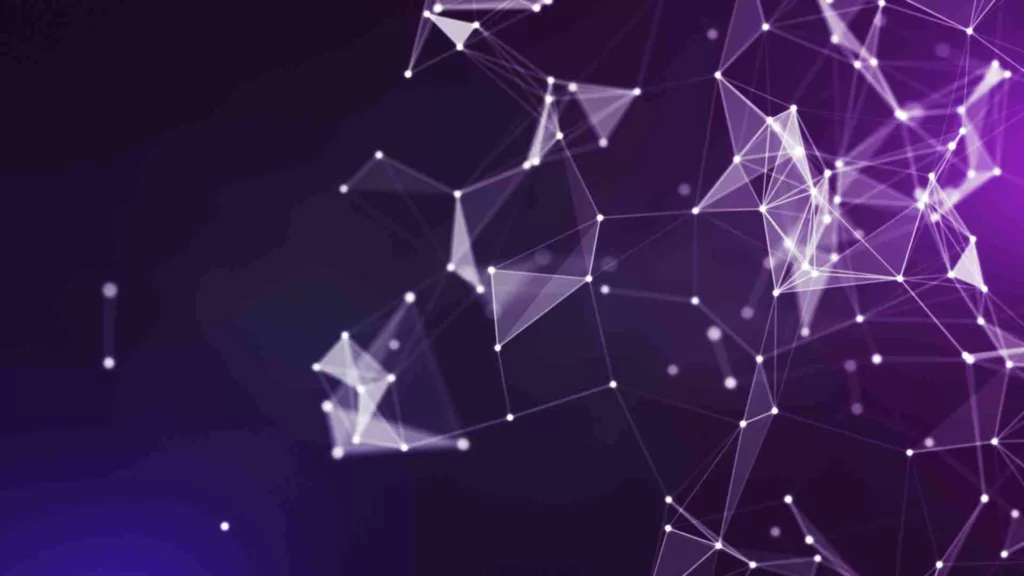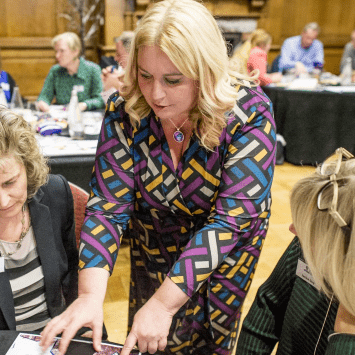Posted in Blog, Entrepreneurship, Facilitation, Innovation by Jo North
Horizon Scanning in a Fast Changing World
Horizon scanning has never been as important for business as it is today.
These are times of significant transition, change, and transformation. Changes are happening at an accelerated pace in energy, technology, social structures, geopolitics, and many other fields. As businesses, it is crucial for us to adapt and navigate through these changes to grow and succeed. We are experiencing a great deal of volatility, uncertainty, complexity, and ambiguity, which makes it challenging to plan for the future.
It can be challenging to identify opportunities and potential risks when there is so much information available and a busy day job to manage. However, horizon scanning is an effective way to do it, and I am here to assist you with that. Horizon scanning involves looking for changes and emerging trends in your industry, and it is essential for growth. I will explain what horizon scanning is, how it differs from predictions and forecasts, and why it is necessary.
Horizon Scanning Article Contents
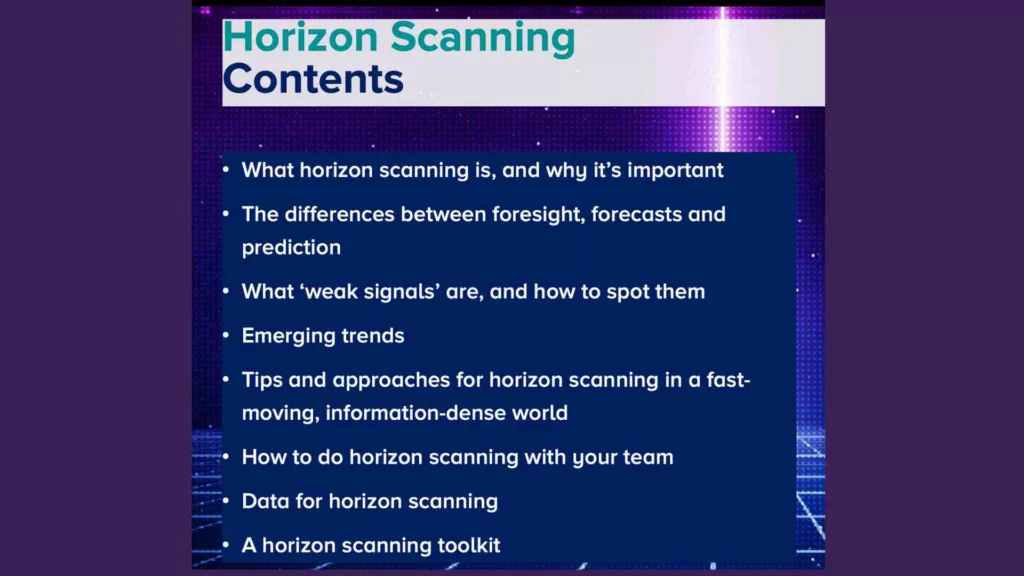
In this article, I will define horizon scanning, explain why it is important, and clarify the differences between foresight, forecasts, and predictions. It’s not about predicting the future accurately or having a crystal ball, but rather about identifying weak signals and spotting them.
I will also provide tips and approaches for doing horizon scanning in a fast-paced, information-dense world. You can perform horizon scanning with your team, customers, and stakeholders as part of a strategic process. You will receive a complete toolkit to help you with horizon scanning.
I hope this explanation is helpful in understanding the importance of horizon scanning. Let’s get started!
What is Horizon Scanning?
Horizon scanning is an effective way to make sure your plans for the future are as well-informed as they can be. It involves exploring potential future scenarios, identifying emerging trends, and assessing their potential impact on your business. Effective strategic visioning and innovation strategy is underpinned by robust horizon scanning.
Horizon scanning is a systematic process of gathering information and useful data to identify potential risks, opportunities, and development. The purpose of horizon scanning is to anticipate changes and be proactive in managing risks. While it’s impossible to see everything coming, working with the information we have allows us to manage risks appropriately and stay ahead of the curve. This is crucial for business resilience, especially considering factors like climate change, energy trends, and security.
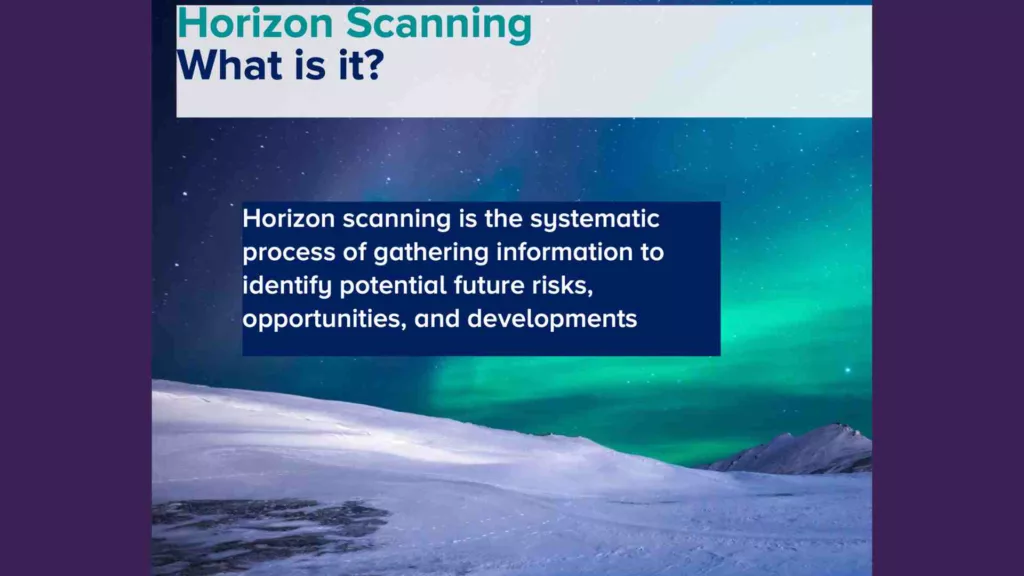
Why Planning Matters Even More in Uncertain Times
A common objection is that there is no point in planning when everything is going to change anyway. However, common sense and experience show that the opposite is true. If we don’t read trends, use insight and look ahead we’ll simply bounce around, reacting ad hoc to the ups and downs of the world around us. Intentionally engaging in horizon scanning means you will help your business to be better prepared for whatever comes its way, both opportunities and threats. You’ll be more strategic, manage risk better and build a substantially more resilient organization.

Change and Opportunity
Out of all of that change, there is always an opportunity. By using horizon scanning you can get good insight into where your opportunities might be. Horizon scanning activities can also be used to engage your stakeholders and really get closer to them whilst understanding what they are looking for and what their aspirations and challenges are too.
It enables businesses to plan for the resources they need and stay compliant with regulatory changes, giving them a competitive edge. Horizon scanning goes beyond conventional planning, requiring future thinking, pushing boundaries, and anticipating change. It is about being open-minded and stretching the thinking to make the right choices. The process helps us to turn the present into the future that we want to achieve.
Horizon Scanning Goes Beyond PESTLE Analysis
Horizon scanning goes beyond using the well-known PESTLE analysis, also known as PESTEL, STEEPLE, or its shorter versions STEP or PEST.
PESTLE Analysis: A Comprehensive Framework
PESTLE analysis is a strategic tool for understanding the macro-environmental factors affecting an organization. It encompasses Political, Economic, Social, Technological, Legal, and Environmental considerations.
Political Factors in PESTLE Analysis
In assessing political factors, the focus is on how government policies and political stability or instability can influence an industry. This includes analyzing tax policies, trade regulations, and political support for various business sectors.
Economic Considerations
Economic considerations involve exploring trends like inflation, interest rates, and economic growth. These elements have direct impacts on business operations, affecting things like purchasing power and profitability.
Social Dynamics
Social dynamics focus on cultural aspects, demographics, lifestyle attitudes, and education levels. Understanding these social factors is crucial for identifying consumer needs, determining market size, and assessing workforce characteristics.
Technological Influences
This aspect of PESTLE analysis is about investigating emerging technologies and innovation trends. It’s essential for identifying opportunities for innovation and understanding potential competitive threats.
Legal Environment
The legal environment review includes understanding current and upcoming laws that could affect business operations. Areas like labor laws, health and safety regulations, and consumer protection laws are considered here.
Environmental Factors
Environmental factors entail considering aspects like climate change, ecological concerns, and sustainability practices. These factors are increasingly vital in the context of global business operations.
PESTLE Analysis is Just the Beginning
PESTLE analysis is instrumental in identifying opportunities and threats, aiding in strategic planning. Regular updates to this analysis are necessary to reflect the dynamic nature of these external factors.
It is crucial to involve your team and stakeholders in the process to ensure the best possible outcomes for your business.
Many businesses stop their horizon scanning once their PESTLE analysis is complete, though, when in reality it should just be the beginning. PESTLE gives you a useful checklist to work through, but your thinking will need greater depth if it is to be insightful and useful.
Foresight, Forecasts and Prediction
As I mentioned earlier, horizon scanning is not about predicting the future with absolute accuracy. No crystal balls needed! It is about exploring different future possibilities. Foresight, forecasts, and prediction all have different meanings, which I’ll explore now.
Foresight is about exploring multiple future possibilities.
Forecasting is estimating a potential future outcome.
Prediction is looking ahead to pinpoint what is going to happen at a particular time.
We use qualitative and quantitative methods for foresight, looking into the long-term to forecast better and more accurately for the short to medium term. Of course, the further we go into the future, the less certain our forecasts become.
Foresight is useful for strategy development and innovation, while forecasts are for planning and budgeting to achieve business strategy. Being adaptable and updating plans as you go is crucial, because things will always change. Unlike prediction, foresight and forecasting are agile, flexible, and responsive.
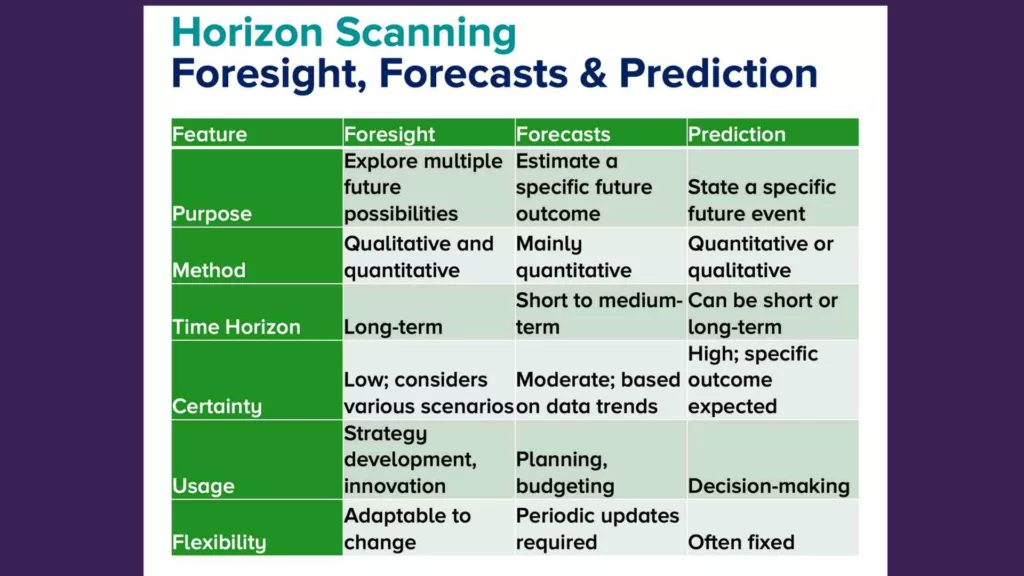
The Importance of Weak Signals
As we use horizon scanning techniques, we must keep our senses tuned to weak signals at all times. These are subtle indications of changes, disruptions, or emerging trends that could potentially alter the course of industries, markets, societies, or technologies.

Such signals can have ripple effects that extend beyond your immediate vicinity. We live in an interconnected world, and it is easy to overlook these signals, which can often be ambiguous. It’s easy to assume that events happening in far-off places won’t affect us or our businesses. The pandemic is a prime example of this. While these weak signals may be ambiguous and easily missed, it’s essential to tune in to them.
Make sure that you identify the underlying shifts, not just short-term trends or fads, unless of course your’e in fast-moving industries such as design, fashion, food, and interiors.
Tune into these signals at all times, and not just at specific points. They are the subtle early indications of emerging trends, changes, or disruptions that have the potential to affect industries, markets, societies, or technologies.
Tips for Successful Horizon Scanning
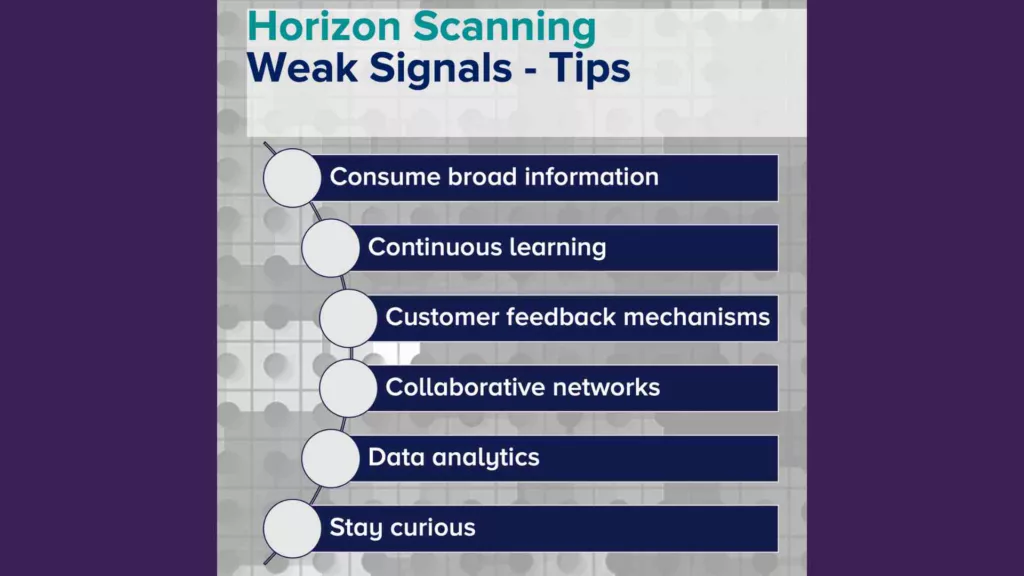
Tip #1. Consume a Wide Range of Information
Consume a wide range of information, not just industry-specific news. As a minimum, consider industries adjacent to your own. For instance, if you’re in the fashion industry, you might want to keep an eye on what other retailers are doing, as well as trends in materials and how the circular economy will impact consumer purchasing decisions. It’s essential to look at a wide range of industries because you can often gain a new perspective and find ways to transfer ideas between them.
Tip #2. Stay Close to Your Customers
Customers needs and aspirations are always evolving. Stay close to your customers, and pay attention to their changing needs and preferences to make sure your business remains relevant and ahead of the curve.
Tip #3. Collaboration is Key
Proactively nurture and collaborate with stakeholders within your innovation ecosystem to stay up-to-date on the latest developments and new trends. Attend thought-leadership conferences and events, build your business network and seek opportunities to engage in knowledge exchange.

Tip #4. Use Data Analytics
Data analytics plays a fundamental role in horizon scanning by offering deep insights into emerging trends and patterns. By analyzing large datasets, you can identify weak signals and early indicators of change.
Through predictive analytics, companies can assess potential risks and opportunities, making informed decisions that align with their long-term objectives. Moreover, data analytics aids in sifting through noise in social media and other digital platforms, providing a clearer picture of the evolving macro-environment.
Access Data Sources
There are excellent free data resources available, such as surveys and research from organisations such as McKinsey and Deloitte. You can subscribe to receive their newsletters. Deloitte has done some great work around sustainability and consumer responses, Accenture is great for technology updates. Arup publishes on design, infrastructure, and emerging trends.
Other free resources include the International Energy Agency, which has heaps of stuff around energy trends, new challenges, new world policies, and how they impact price, consumption, availability, usage and more.
Gartner releases its hype cycle for emerging technologies every year, showing what is on the rise, what is maturing, what is dipping, and the time new technologies are likely to take to go on that journey.
Every year, Mintel publishes consumer trends and research which is incredibly insightful. The 2024 Mintel is out right now and it focuses on being human, relationships, sustainability, and accountability.
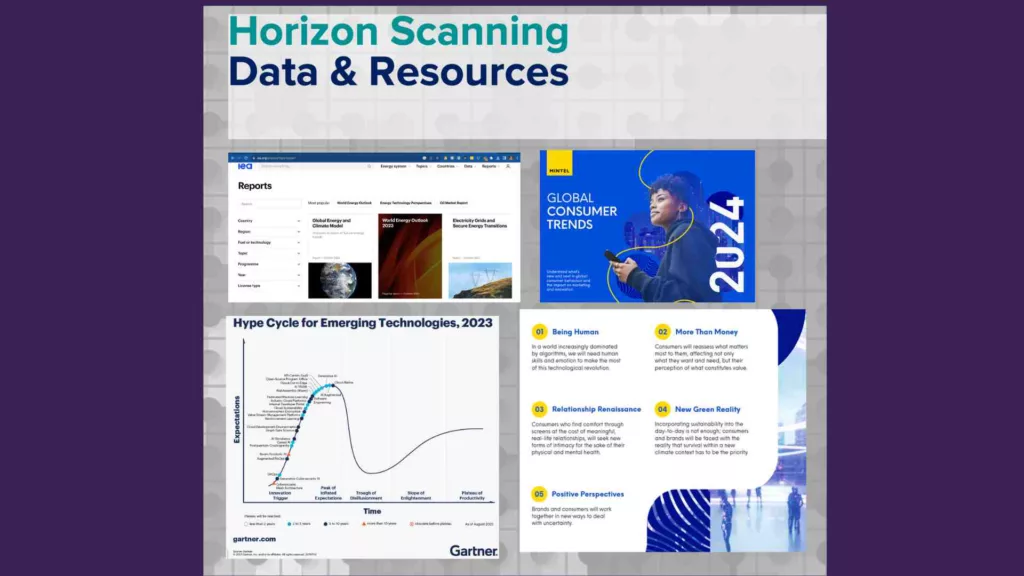
Read Something New Every Week
While buying data can be expensive and not necessarily useful, industry events and bodies are constantly creating data. It is essential to stay on top of this by reading at least something new every week, even if it is only a 10-minute read. This helps you stay informed. If you need information that relates to your specific situation, do get in touch, and I will do my best to help you.
Tip #5. Stay Curious
Staying curious is important for effective horizon scanning. Curiosity drives the exploration of unknown or less obvious areas, leading to the discovery of emerging trends and weak signals that others might overlook.
This inquisitive, growth mindset encourages continuous learning and adaptation, essential in a rapidly changing world. It fosters a deeper understanding of diverse factors affecting an industry, from technological innovations to shifting societal norms.
Curiosity also promotes open-mindedness and the willingness to question assumptions, which is critical for anticipating and preparing for future challenges and opportunities.
In essence, curiosity is the fuel that powers the engine of foresight and strategic planning.
Horizon Scanning Toolkit
The Horizon Scanning Toolkit is a set of tools that can be used together or separately. You can use them individually or in combination, as a team or on your own, depending on your situation. In this overview, I will explain each of the tools and how to use them effectively.
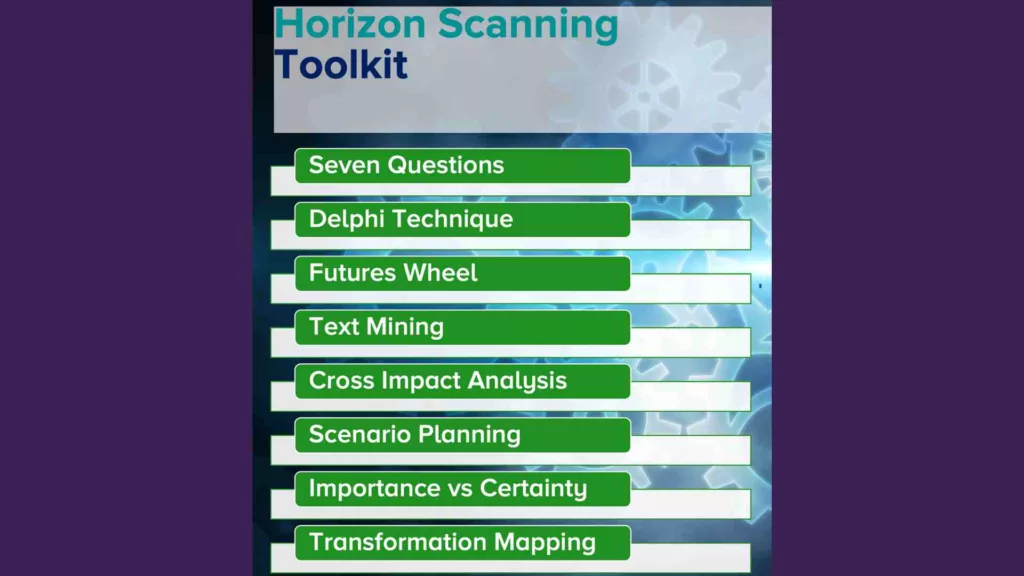
The Seven Questions Horizon Scanning Technique
The seven questions horizon scanning technique is a scenario planning approach developed by Shell. It involves thinking about different possibilities for the future and working through each one. The approach can be used in different ways such as through interviewing, questionnaires, surveys or focus groups. You can modify the questions to suit your specific industry or situational requirements.
Here are the seven questions:
- If you could speak to someone from the future who had knowledge about your business area, what would you ask them?
- What is your vision for success?
- What are the dangers of not achieving your vision?
- What changes need to occur in systems, relationships, decision-making processes, and culture for your vision to be realized?
- Looking back, what are the successes we can build on? The failures we can learn from?
- What needs to be done now to ensure that your vision becomes a reality?
- If you had absolute authority and could do anything, is there anything else you would do?
The seven questions technique helps you get a sense of where people see the future, what their hopes are, and what they are worried or concerned about. It is a good creative and very engaging way of actually doing this type of horizon scanning. I do recommend that you capture all of the outputs from the things people say, then put it all into a metaphorical ‘bucket’ of horizon scanning findings to analyze in the round.

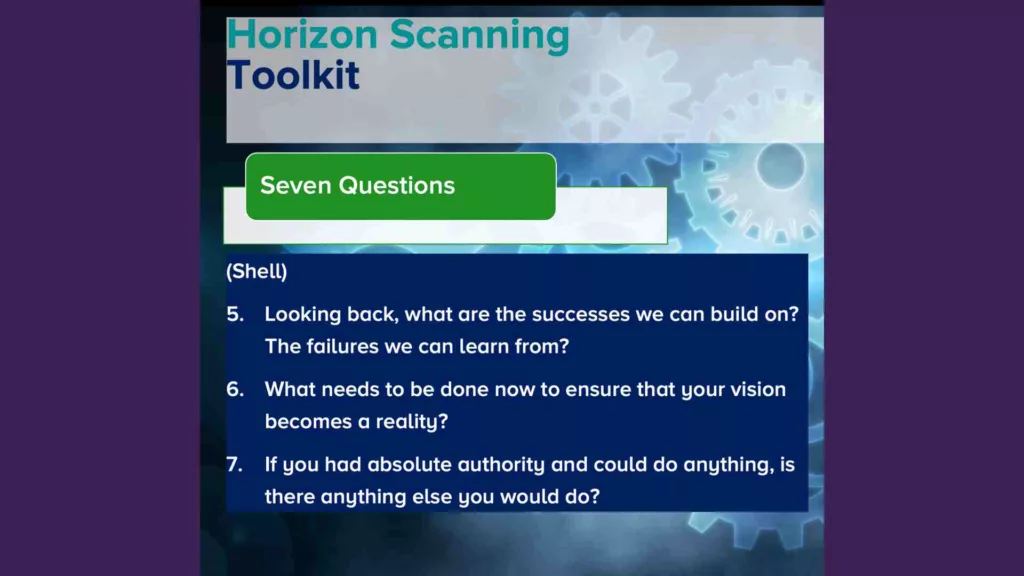
The Delphi Technique
The Delphi technique is a process of tapping into the collective wisdom and experience of experts or people who are closely related to a subject or have knowledge of different aspects of the environment.
In the Delphi Technique, you decide on a topic for discussion and invite participants to answer a questionnaire. You can use cards to help groups work together to capture ideas and intelligence from different people. The Delphi technique can be done asynchronously, meaning people can work at different times and in different places, making it a flexible and convenient way to gather insights. When selecting participants, it’s important to be thoughtful about who you invite, as the right mix of people can provide valuable insights that can inform your strategy effectively brilliantly.
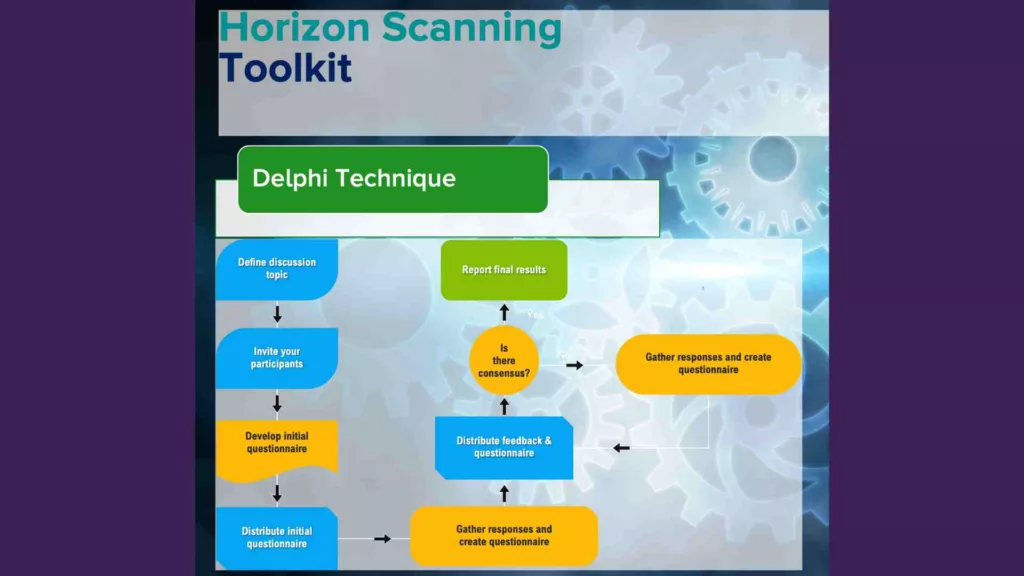
I used the seven questions above combined with the Delphi technique this week at Maritime Innovation Week 2023 in a conference activity, to capture the collective ideas of the delegates on the likely future trends for the maritime industry.
Futures Wheel Horizon Scanning Activity
The Futures Wheel’is a tool that helps you think about the changes that are happening or likely to happen and their impacts. It encourages you to consider the indirect or secondary results of these changes.
To use the tool, start with different central topics such as energy, sustainability, technology, digital AI or any other relevant topic. Then, ask your team or stakeholders to share their thoughts on the direct results or impacts of the trends that are likely to take place. You can place these answers in a circle outside of the center.
Next, ask them to think about the indirect results of all the direct results, and place them in an outer circle around the edge (please see image). This approach helps you understand the interconnections and impacts of different trends. You can also use the PESTLE analysis to identify the opportunities and threats, and then think about the indirect results.
I recommend that you use several different wheels, each with a different topic, as this will help you explore different ideas. The wheels may get quite big with all of the different ideas, but this exercise will push your thinking further and make it even more useful.
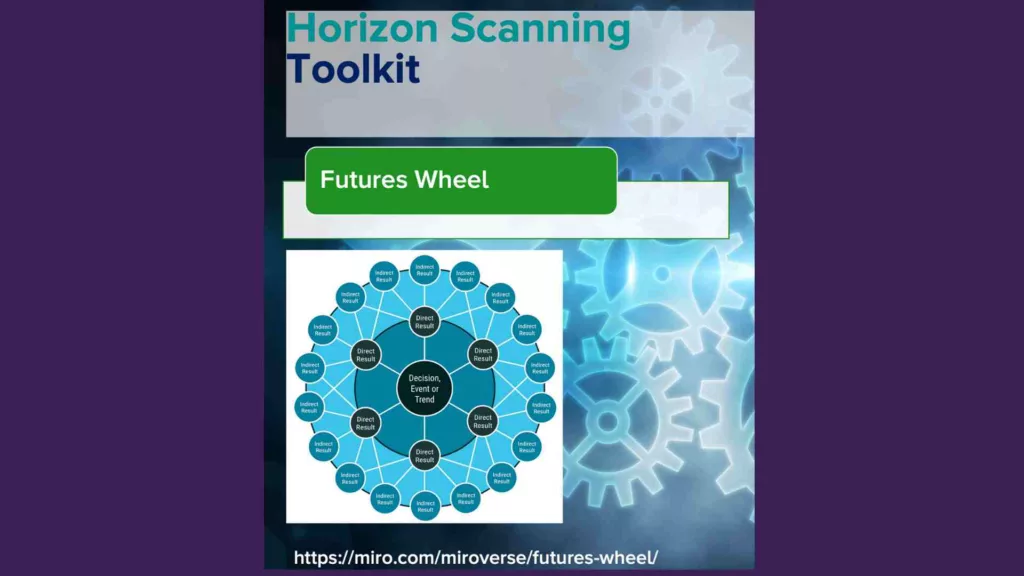
Text Mining
Text mining involves searching for information. A great way to do this is by using tools such as Chat GPT, but it is important to remember that the information provided may not always be accurate. However, generative AI can be useful as it provides a starting point and generates ideas and questions that can help you to dig deeper into a particular subject.
One approach to using Chat GPT is to ask for an executive summary and references upfront, which can save time and effort. For instance, asking for an executive summary of energy trends between now and 2030 can yield a high-level overview of the topic.
Similarly, prompting Chat GPT to create a horizon scanning table for different energy types can provide insights into how different aspects like market, demand, technology, policy regulation, risks, and investment are likely to evolve from now until 2030. Again, it is important to verify the information provided by Chat GPT before using it as a reference. However, the tool can be a useful starting point for navigating complex topics. The best part is that it only takes a few minutes to generate useful insights.

Cross Impact Analysis
Cross-impact analysis is a technique that helps to identify the potential impact of combining different trends or variables. Unlike the traditional approach of looking at individual categories, cross-impact analysis considers the interaction between two or more trends. For example, when we combine the trend of an ageing population with an increase in social media usage, we can predict the likely outcome of these two trends together.

By using coordinates, similar to playing battleships, we can identify the key variables and classify their impact as strongly positive, positive, neutral, negative, or strongly negative. This technique is useful in advancing our thinking and gaining more insightful ideas. When we make these connections and dig deeper, we can get a better understanding of the potential outcomes and impacts of these trends.
Scenario Planning
Scenario planning is a technique used to mitigate risk, identify opportunities and think through possibilities for your strategy and innovation.
By thinking through these possibilities, you can mitigate risks, identify opportunities, and refine your strategy and innovation plan accordingly. While this approach is often associated with Shell, it can be applied to any industry and help organizations prepare for any potential future scenarios.
Scenario Analysis for Horizon Scanning: A Brief Guide
- Identify Key Factors: Begin by identifying critical drivers of change in your industry. These could be technological advancements, economic shifts, regulatory changes, or social trends.
- Develop Scenarios: Create diverse scenarios based on different combinations of these key factors. Each scenario should represent a plausible future state, ranging from optimistic to pessimistic outcomes.
- Analyze Impacts: Assess how each scenario could impact your organization. Consider both opportunities and threats that may arise.
- Develop Strategies: For each scenario, formulate strategies that would enable your organization to respond effectively. This includes contingency plans for adverse scenarios and exploitation plans for favorable ones.
- Monitor Indicators: Establish indicators that signal which scenario is becoming more likely. Regularly monitor these indicators to adjust your strategies as needed.

Importance vs Certainty Matrix
When faced with different scenarios, it’s helpful to use a matrix orgrid that compares importance versus certainty.
Use virtual or real sticky notes to plot your ideas.
On one axis, you can plot from low to high importance, and on the other axis, plot from low to high certainty.
Keep an eye on everything, but don’t worry too much about the things with low importance or high certainty. Instead, focus on items with high importance and low certainty, as these are crucial and can change unexpectedly.
It’s important to prioritize these items because you know they will happen eventually.

Transformation Mapping
Transformation mapping is the final step in the process of foresight and forecasting. After gathering all the information and insights from horizon scanning, it’s time to use the priorities from your importance vs certainty matrix, and assess how things are likely to play out in the future.
The transformation map is an excellent framework for this purpose. It consists of a future state in the top right- hand corner, and all the different aspects such as products, geographies, businesses, social, technological, and environmental factors around the edges. Starting from the current state of each aspect, you can project where you will be in one, three, five, ten, or fifteen years. This helps you to get a clear picture of the external environment and identify opportunities and threats.

You can then assess your organization’s strengths and weaknesses internally and make plans to align your mission, vision, values, and purpose with your contribution to this environment. You can also identify the resources and funds required and communicate your vision to your team.
Next Steps
That’s it for the toolkit. If you would like a deep dive into one of the tools with some worked examples in future sessions, please let me know. Otherwise, I hope this toolkit has been useful and inspires you to take action.
Horizon Scanning: A Recap
Horizon scanning is a systematic process essential for identifying future trends and potential impacts in various sectors. It involves a systematic examination of potential threats and opportunities, focusing on new information that signals changes. This approach helps in strategic planning, especially in fields like healthcare research, where anticipating future developments is crucial.
The Role of Environmental Scanning and Weak Signals
Environmental scanning plays a pivotal role in horizon scanning. It encompasses monitoring social media, public events, and other sources to detect weak signals of change. These signals, often at an early stage, can indicate emerging technologies or social change. Recognizing these signals allows organizations to prepare for long-term strategic foresight.
Strategic Foresight in Decision-Making
Strategic foresight is central to decision-making processes. It helps in identifying priority areas and formulating an action plan based on evidence base and ethical considerations. By analyzing such changes, especially in the context of climate change and environmental issues, decision-makers can make strategic decisions that have high impact and align with their long-term goals.
Artificial Intelligence and Machine Learning in Horizon Scanning
Artificial intelligence and machine learning are revolutionizing horizon scanning. They offer new approaches to analyze large datasets, providing critical insights into future threats and opportunities. These technologies complement human intelligence, enhancing the effectiveness of horizon scanning.
The Delphi Technique and its Applications
The Delphi technique, a proven foresight method, involves consulting experts to generate a consensus on critical issues, such as new regulations, technological development, and potential ethical issues. This method is particularly effective in healthcare research and strategic planning, offering a practical guide for navigating an uncertain future.
Implications for Innovators
For innovators, effective horizon scanning involves understanding the relevance of new technologies, geographic area specific issues, and environmental trends. By focusing on signals of change and leveraging tools like data science, innovators can identify areas with the highest potential for growth and innovation.
